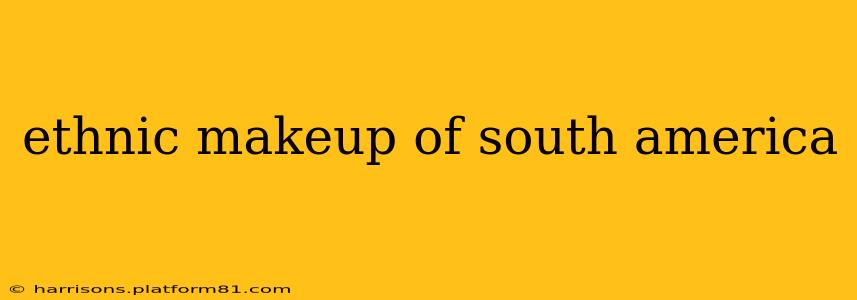South America boasts a rich and complex tapestry of ethnicities, a legacy shaped by centuries of indigenous populations, European colonization, African enslavement, and subsequent migration. Understanding this intricate mix requires looking beyond simple percentages and exploring the historical forces that have shaped the continent's demographic landscape. This article delves into the diverse ethnic makeup of South America, addressing common questions and providing a nuanced perspective on this fascinating subject.
What are the main ethnic groups in South America?
The main ethnic groups in South America can be broadly categorized as Indigenous, European, African, Asian, and mixed-race populations (often referred to as mestizos, mulatos, or other terms reflecting specific combinations). However, it's crucial to understand that these categories are not mutually exclusive, and many individuals identify with multiple backgrounds.
-
Indigenous Peoples: South America is home to hundreds of distinct Indigenous groups, each with its own unique language, culture, and traditions. These groups, who were the original inhabitants of the continent, represent a significant part of the population, although their exact numbers are often debated due to historical inaccuracies and varying self-identification practices. Major Indigenous groups include the Quechua and Aymara in the Andes region, and numerous other tribes throughout the Amazon rainforest and other areas.
-
European Descendants: The arrival of Europeans, primarily Spanish and Portuguese, during the colonial era dramatically altered the demographic landscape. Their descendants constitute a large portion of the population in many South American countries, particularly in urban areas. Other European groups, including Italians, Germans, and British, also contributed to the genetic and cultural mix.
-
African Descendants: The transatlantic slave trade had a profound and lasting impact on South America. Millions of Africans were forcibly brought to the continent, their descendants now forming significant populations in countries like Brazil, Colombia, and others. Their contributions to the cultural richness of South America are undeniable, reflected in music, dance, cuisine, and language.
-
Asian Descendants: More recent migration from Asia, particularly from Japan, China, and Korea, has also added to South America's ethnic diversity. These communities are particularly prominent in urban centers and have made significant contributions to the economies and cultures of their respective countries.
What percentage of South America is Indigenous?
Determining the exact percentage of Indigenous people in South America is challenging due to inconsistent data collection methods and the complexities of self-identification. Official census data often underrepresents Indigenous populations due to historical marginalization and difficulties in accessing remote communities. While overall percentages vary greatly by country, it's safe to say that Indigenous populations represent a substantial and vital part of the continent's cultural heritage. Further research and improved data collection are crucial for a more accurate representation.
How has colonization affected the ethnic makeup of South America?
Colonization profoundly reshaped South America's ethnic makeup. The arrival of Europeans led to the displacement and decimation of Indigenous populations through disease, warfare, and forced labor. The transatlantic slave trade brought millions of Africans to the continent, creating a new layer of diversity but also perpetuating systems of oppression. These historical events continue to shape social dynamics and influence the ethnic composition of various regions.
What are the most common mixed-race groups in South America?
South America is characterized by a significant mixed-race population resulting from centuries of intermarriage between Indigenous, European, and African populations. Common mixed-race classifications include mestizos (Indigenous and European), mulatos (African and European), and zambos (Indigenous and African). However, it is important to note that these categories are broad generalizations, and the actual genetic and cultural backgrounds of individuals can be far more complex and nuanced. The specific terminology used also varies between countries.
What is the racial diversity like in different South American countries?
Racial and ethnic diversity varies significantly across South American countries. Brazil, for instance, has a vast and diverse population with significant proportions of African and mixed-race individuals. In contrast, countries like Argentina and Uruguay have predominantly European ancestry. The Andean nations, such as Peru, Bolivia, and Ecuador, have substantial Indigenous populations. Understanding these variations requires examining the specific historical contexts and migratory patterns of each country.
Conclusion:
The ethnic makeup of South America is a vibrant and ever-evolving mosaic. Understanding this diversity requires acknowledging the complexities of its history and recognizing the richness that arises from the interplay of different cultures and backgrounds. It is vital to move beyond simplistic categorizations and appreciate the unique identities and experiences of individuals within the broader context of South America's multiethnic heritage. Further research and a commitment to inclusive data collection will continue to shed light on this fascinating and important aspect of the continent's identity.
